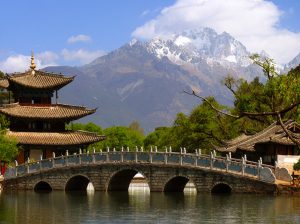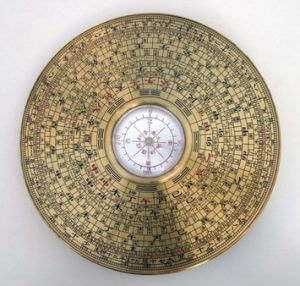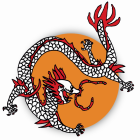The Chinese art to determine the quality of a location dates back to around 1000 BC. Formerly called Kan Yu (essentially means „Heaven and Earth“) or Di Li („Earth patterns“), since around the 4th century it is called “Feng Shui” (風水 fēng shuĭ) meaning “wind and water“. This term shows the essential principle of Feng Shui, the distribution and strategic collection of Qi (life energy) at a location.
The Chinese have recognized long ago that human beings as a part of the cosmos are influenced by heaven as well as by earth. The energetic circumstances of heaven only can be observed and be attuned to, but we have the choice of location. We can select a house and shape it in a special way to direct its inherent energy for good use.
In ancient times Feng Shui primarily was used for tombs (Yin Feng Shui) as a pertinent tool for ancestor worship while the descendants could also benefit from. Gradually, also the houses of the living were considered (Yang Feng Shui). First, Feng Shui was reserved for the emperor to ensure his power, wealth and survival, later on also the folk sought the advice of Feng Shui masters, particularly the elite.
Qi rides the wind and scatters, but is retained when encountering water.
(葬書 Zhangshu)

The two schools of Feng Shui
There has been evolved two fundamental systems of Feng Shui practised side by side to the present day: San He (三 合 sān hé, „Three harmonies“) and San Yuan (三 元 sān yuán, „Three cycles”). San He Feng Shui is mainly about landscape forms like mountains and waterways. San Yuan Feng Shui studies the regularities of Qi, especially with regard to time cycles.
 Both systems make use of the Chinese compass (chin. 羅盤 luópán), a finely tuned tool to measure a site in relation to directions and notable features in the environment.
Both systems make use of the Chinese compass (chin. 羅盤 luópán), a finely tuned tool to measure a site in relation to directions and notable features in the environment.
The dissemination of Feng Shui and its dilution
Until the origin of People’s Republic of China Feng Shui has been a vibrant part of the Chinese culture with a long list of literature and a sequence of grandmasters started with Yang Yun Song (9th c.).
During the Communist period Feng Shui was reprobated together with all the other methods of Chinese Metaphysics so that the masters were either be killed or had been emigrated. The result was that the greatest Feng Shui experts now reside in Taiwan, Singapore, Malaysia, Hong Kong (British until 1997) and in the West.
Feng Shui is part of the Chinese Metaphysics whose disciplines are connected by the theory of the Five Elements. Therefore not only experts, but also masters of kung fu or Qigong dealt with Chinese dietetics, Feng Shui or neighboring disciplines.
Consequently the Buddhist Black Hat Sect came to the United States with simply superficial knowledge about Feng Shui and, influenced by the Western marketing methods, they turned it into cash. In the USA this New Age Feng Shui caused a hype which spread over Europe later on. In this variation usually there do not take place accurate examinations or measurements of compass points, but it bases itself on artefacts like three-legged money frogs, fu dogs, ba gua mirrors and so on. In the public’s perception this form persists, although it has not much in common with authentic Feng Shui.
In esoteric circles Feng Shui even was degraded to a method of choosing colours and furniture without comprehension of the basic concept of energy flow. Its efficacy therefore is very limited or even counterproductive.
Fortunately, meanwhile there are experts teaching the original theories also in Western countries offering us the possibility to benefit from this powerful tool.
